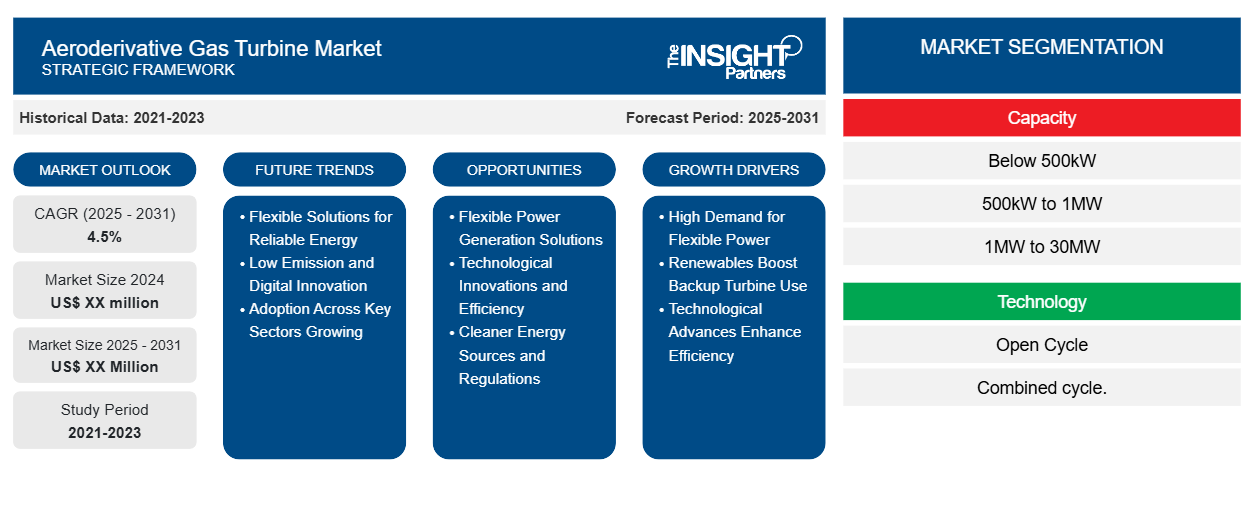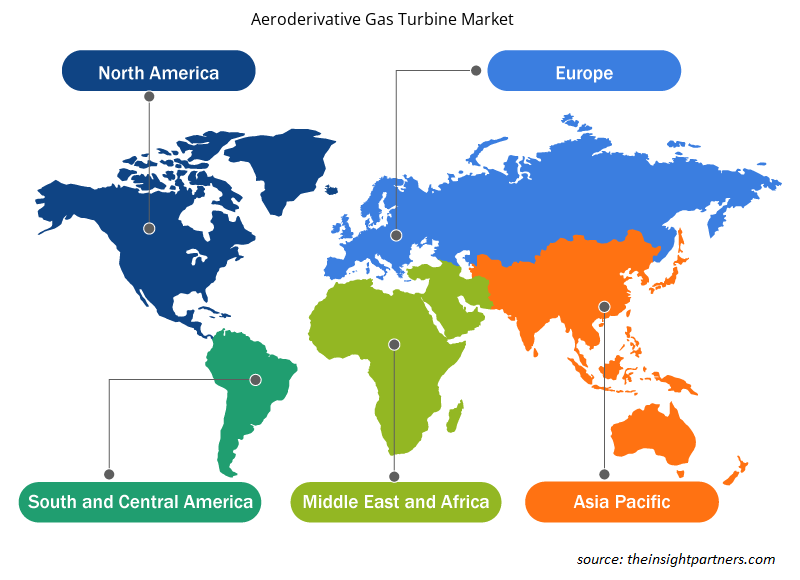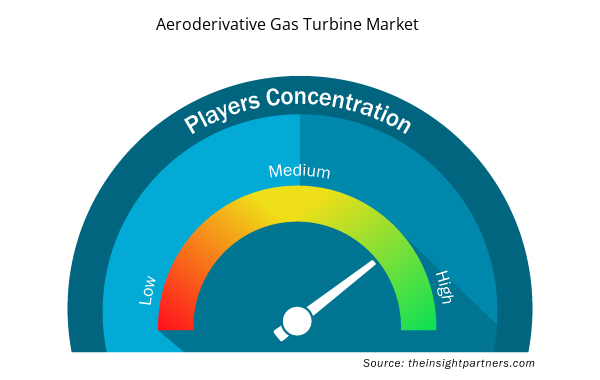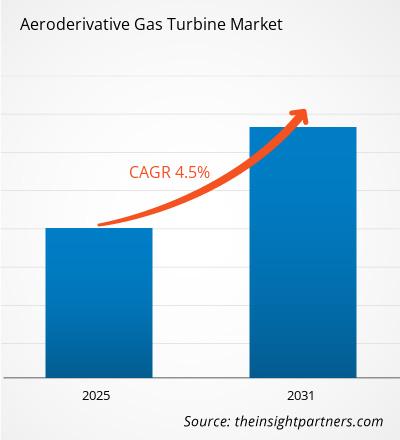The Aeroderivative Gas Turbine Market is expected to register a CAGR of 4.5% from 2025 to 2031, with a market size expanding from US$ XX million in 2024 to US$ XX Million by 2031.
The Aeroderivative Gas Turbine Market report covers analysis By Capacity, Technology, and Application. The report provides a global and regional overview of the market.
Purpose of the Report
The report Aeroderivative Gas Turbine Market by The Insight Partners aims to describe the present landscape and future growth, top driving factors, challenges, and opportunities. This will provide insights to various business stakeholders, such as:
- Technology Providers/Manufacturers: To understand the evolving market dynamics and know the potential growth opportunities, enabling them to make informed strategic decisions.
- Investors: To conduct a comprehensive trend analysis regarding the market growth rate, market financial projections, and opportunities that exist across the value chain.
- Regulatory bodies: To regulate policies and police activities in the market with the aim of minimizing abuse, preserving investor trust and confidence, and upholding the integrity and stability of the market.
Aeroderivative Gas Turbine Market Segmentation
Capacity
- Below 500kW
- 500kW to 1MW
- 1MW to 30MW
- 30MW to 70MW
- Above 70MW.;
Technology
- Open Cycle
- Combined cycle.
Application
- Power Plants
- Oil and Gas
- Process Plants
- Aviation
- Marine
- Others.
Geography
- North America
- Europe
- Asia-Pacific
- South and Central America
- Middle East and Africa
Customize This Report To Suit Your Requirement
You will get customization on any report - free of charge - including parts of this report, or country-level analysis, Excel Data pack, as well as avail great offers and discounts for start-ups & universities
Aeroderivative Gas Turbine Market: Strategic Insights

- Get Top Key Market Trends of this report.This FREE sample will include data analysis, ranging from market trends to estimates and forecasts.
Aeroderivative Gas Turbine Market Growth Drivers
- High Demand for Flexible Power: High demand for efficient and flexible options of power generation drives the growth of the aero-derivative gas turbine market. The product offers high efficiency and facilitates rapid start-up, which makes it necessary to meet peak energy demand. Low-emission technologies continue to gain increased focus as countries are seeking cleaner energy alternatives, thereby enhancing market growth.
- Renewables Boost Backup Turbine Use: The rising use of renewable sources of energy, such as wind and solar-based power systems, directly impacts the demand for aero-derivative gas turbines since the turbines are widely used for backup power systems due to their prompt response time and operational efficiency. In the context of investments in hybrid power systems for use with renewables, market trends are indicating that aeroderivative technologies are picking up. Market research reveals that the trend is catalyzing sharp market growth and increasing the size and market share of the global market.
- Technological Advances Enhance Efficiency: Technological developments in the field of aeroderivative gas turbine design and materials also influence market dynamics. Technological developments like higher combustion efficiency and advanced heat recovery systems allowed the turbines to be used for performance enhancement. This reduces the cost of operations and is in accord with global energy efficiency goals established for market growth. Market reports from various places have shown that such developments and reductions in operational costs have increased the global market share and provided a more favorable overview of the market, thus bringing about healthy competition in the market.
Aeroderivative Gas Turbine Market Future Trends
- Flexible Solutions for Reliable Energy: The aeroderivative gas turbine market is tilting towards flexible power generation solutions with the growing need for reliable energy supply in unstable demand dynamics. Market dynamics are, of course, entirely favorable to fast-output turbines that can integrate renewable energy sources perfectly. A SWOT analysis shows opportunities for key players to innovate and enhance their efficiency. With the adoption of market strategies with adaptability and reliability as top priorities, this segment is expected to grow steadily for years to come.
- Low Emission and Digital Innovation: Rapid technological innovations are shifting the aeroderivative gas turbine market with increased efficiency and lesser emission. Market leaders in this industry invest in research and development to design more advanced turbines and increase their capability. A PEST analysis points out that due to pressure from the government, energy sources would be cleaner; thus, it may be one of the factors affecting dynamics in the market. Companies with innovative steps in markets applying digital monitoring and predictive maintenance can even enhance performance and decrease the cost of operating, thus they will be able to compete while the market is continuously changing rapidly.
- Adoption Across Key Sectors Growing: Latest developments in aeroderivative gas turbines, with increasing adoption across oil and gas, aviation, and power generation sectors, illustrate that the rationale for adoption would primarily be driven by operational needs to match diverse operational demands for efficient, reliable energy solutions. Market dynamics indicate the leading players are focusing on strategic partnerships intended to further enhance their market reach. On the SWOT analysis, its strength includes versatility and adaptability on the part of the firm itself; sector-specific applications in market strategies can offer new growth opportunities.
Aeroderivative Gas Turbine Market Opportunities
- Flexible Power Generation Solutions: The aeroderivative gas turbine market is tilting towards flexible power generation solutions with the growing need for reliable energy supply in unstable demand dynamics. Market dynamics are, of course, entirely favorable to fast-output turbines that can integrate renewable energy sources perfectly. A SWOT analysis shows opportunities for key players to innovate and enhance their efficiency. With the adoption of market strategies with adaptability and reliability as top priorities, this segment is expected to grow steadily for years to come.
- Technological Innovations and Efficiency: Rapid technological innovations are shifting the aeroderivative gas turbine market with increased efficiency and lesser emission. Market leaders in this industry invest in research and development to design more advanced turbines and increase their capability. A PEST analysis points out that due to pressure from the government, energy sources would be cleaner; thus, it may be one of the factors affecting dynamics in the market. Companies with innovative steps in markets applying digital monitoring and predictive maintenance can even enhance performance and decrease the cost of operating, thus they will be able to compete while the market is continuously changing rapidly.
- Cleaner Energy Sources and Regulations: Latest developments in aeroderivative gas turbines, with increasing adoption across oil and gas, aviation, and power generation sectors, illustrate that the rationale for adoption would primarily be driven by operational needs to match diverse operational demands for efficient, reliable energy solutions. Market dynamics indicate the leading players are focusing on strategic partnerships intended to further enhance their market reach. On the SWOT analysis, its strength includes versatility and adaptability on the part of the firm itself; sector-specific applications in market strategies can offer new growth opportunities.
Aeroderivative Gas Turbine Market Regional Insights
The regional trends and factors influencing the Aeroderivative Gas Turbine Market throughout the forecast period have been thoroughly explained by the analysts at Insight Partners. This section also discusses Aeroderivative Gas Turbine Market segments and geography across North America, Europe, Asia Pacific, Middle East and Africa, and South and Central America.

- Get the Regional Specific Data for Aeroderivative Gas Turbine Market
Aeroderivative Gas Turbine Market Report Scope
| Report Attribute | Details |
|---|---|
| Market size in 2024 | US$ XX million |
| Market Size by 2031 | US$ XX Million |
| Global CAGR (2025 - 2031) | 4.5% |
| Historical Data | 2021-2023 |
| Forecast period | 2025-2031 |
| Segments Covered |
By Capacity
|
| Regions and Countries Covered | North America
|
| Market leaders and key company profiles |
Aeroderivative Gas Turbine Market Players Density: Understanding Its Impact on Business Dynamics
The Aeroderivative Gas Turbine Market market is growing rapidly, driven by increasing end-user demand due to factors such as evolving consumer preferences, technological advancements, and greater awareness of the product's benefits. As demand rises, businesses are expanding their offerings, innovating to meet consumer needs, and capitalizing on emerging trends, which further fuels market growth.
Market players density refers to the distribution of firms or companies operating within a particular market or industry. It indicates how many competitors (market players) are present in a given market space relative to its size or total market value.
Major Companies operating in the Aeroderivative Gas Turbine Market are:
- General Electric
- Mitsubishi Hitachi Power Systems
- Siemens
- Wood Group
- Kawasaki Heavy Industries
Disclaimer: The companies listed above are not ranked in any particular order.

- Get the Aeroderivative Gas Turbine Market top key players overview
Key Selling Points
- Comprehensive Coverage: The report comprehensively covers the analysis of products, services, types, and end users of the Aeroderivative Gas Turbine Market, providing a holistic landscape.
- Expert Analysis: The report is compiled based on the in-depth understanding of industry experts and analysts.
- Up-to-date Information: The report assures business relevance due to its coverage of recent information and data trends.
- Customization Options: This report can be customized to cater to specific client requirements and suit the business strategies aptly.
The research report on the Aeroderivative Gas Turbine Market can, therefore, help spearhead the trail of decoding and understanding the industry scenario and growth prospects. Although there can be a few valid concerns, the overall benefits of this report tend to outweigh the disadvantages.
- Historical Analysis (2 Years), Base Year, Forecast (7 Years) with CAGR
- PEST and SWOT Analysis
- Market Size Value / Volume - Global, Regional, Country
- Industry and Competitive Landscape
- Excel Dataset



Report Coverage
Revenue forecast, Company Analysis, Industry landscape, Growth factors, and Trends

Segment Covered
This text is related
to segments covered.

Regional Scope
North America, Europe, Asia Pacific, Middle East & Africa, South & Central America

Country Scope
This text is related
to country scope.
Frequently Asked Questions
Some of the customization options available based on request are additional 3-5 company profiles and country-specific analysis of 3-5 countries of your choice. Customizations are to be requested/discussed before making final order confirmation, as our team would review the same and check the feasibility.
The report can be delivered in PDF/PPT format; we can also share excel dataset based on the request.
Key companies in this market are: General Electric, Mitsubishi Hitachi Power Systems, Siemens, Wood Group, Kawasaki Heavy Industries, Solar Turbines, MTU Aero Engines, Ansaldo Energia, Sulzer
The Aeroderivative Gas Turbine Market is expected to register a CAGR of 4.5% from 2023-2031.
Key future trends in this market are - Demand for efficient power generation, Growth in renewable energy integration, Advancements in turbine technologies
The major factors impacting the Aeroderivative Gas Turbine Market are: Technological Advancements, Expansion of Renewable Energy Sources, and Growing Demand for Efficient Power Generation
Trends and growth analysis reports related to Energy and Power : READ MORE..
1.General Electric
2.Mitsubishi Hitachi Power Systems
3.Siemens
4.Wood Group
5.Kawasaki Heavy Industries
6.Solar Turbines
7.MTU Aero Engines
8.Ansaldo Energia
9.Sulzer
10.MAN Diesel and Turbo

 Get Free Sample For
Get Free Sample For